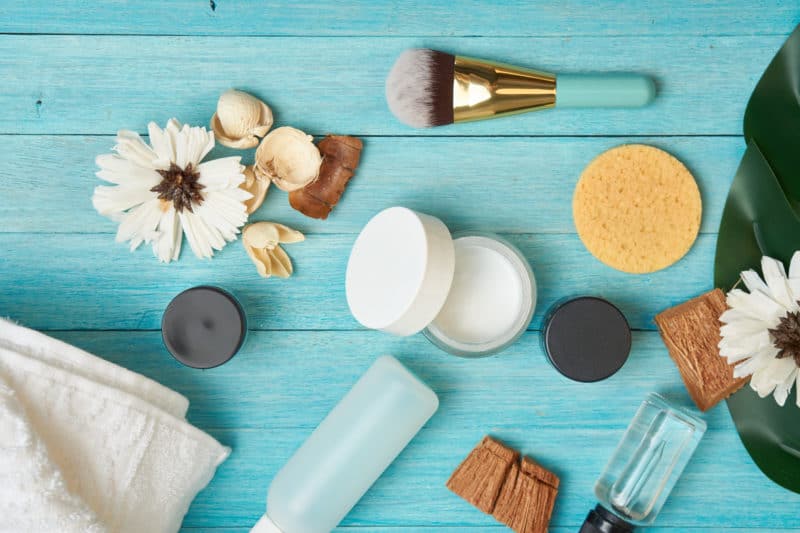

In today’s market everywhere you turn you see labels for “natural” or “organic” products being sold. However, the regulations on what technically is “natural” or “organic” can be misleading.
Although you want to trust brands which market their products as healthy and natural for you – can you?
You’ll be able to advocate for your own health by learning about the “Dirty Dozen” – the ingredients which you should avoid in your personal care products
Why Should You Worry About the Dirty Dozen?
Studies confirm certain toxic chemicals found in cosmetics and skin care products have harmful effects on your body. Harmful effects of chemicals in cosmetics have been linked to cancer, reproductive and endocrine abnormalities, as well as neurotoxicity. So you might be confused as to why you see these same studies show these toxic ingredients in skin care products are “safe to use?”
This is because studies focus on the concentration of toxic ingredients in one certain product. For this fact, they’re able to deem products – safe for use. But they forget Americans don’t just use one skin care product a day.
The average American woman uses 12 personal care products a day and men use an average of 6 personal care products a day. And there are typically several toxic ingredients in each item.
Think of your body as a bucket and each grain of sand as a toxin. A couple sprinkles of sand in your bucket isn’t so bad, but as the sand adds up your toxic burden starts affecting you more. So regardless of the concentration in one product your toxic burden becomes heavier once you start putting on the second, third, or fourth product.
Top 12 Toxic Ingredients in Your Personal Care Products
Simply reading the ingredient labels on your personal care products and cosmetics may make a significant difference in reducing your toxic burden. The following list of harmful chemicals are found in a wide array of products and should be avoided due to their negative effects on your body.
- BHA (Butylated Hydroxyanisole) AND BHT (Butylated Hydroxytoluene)
These synthetic antioxidants are also used in personal care products as a type of preservative. Because of their carcinogenic and endocrine disruptor effects on the skin and body, BHA and BHT are not considered safe in cosmetics or skin care products.
BHA and BHT have been linked to the following health issues:
- Skin allergies
- Liver damage
- Kidney dysfunction
- Thyroid issues
- Cancer
- Lung tumors
- Reproductive problems
- Irregular blood clotting
- Coal tar dyes
Other names for coal tar dyes include P-phenylenediamine, FD&C, D&C, or “CI” followed by a number. Some coal tar dyes are banned in food products, but you can still find these artificial coloring agents in your hair dyes, lipsticks, shampoos, and more.
Coal tar dyes have been linked to the following health issues:
- Eye irritations
- Blindness
- Skin reactions
- Cancer
- Diethanolamine (DEA) related ingredients
To make your skin care products sudsy or creamy companies use a harmful ingredient which you should avoid called diethanolamine (DEA). With prolonged use of these toxins, they cause adverse health effects.
In California’s Office of Environmental Health Hazards Assessment on DEA, they found systemic toxicity occurs in many tissues including the nervous system, liver, kidney, reproductive system, and bloodstream.
- Dibutyl phthalate (DBP)
Dibutyl phthalate is a commonly used plasticizer found in personal care products. DBP was added to California’s Proposition 65 list of suspected teratogens. This means it’s been known to cause malformation of embryos.
DBP is an endocrine disruptor which can potentially affect your reproductive system and other hormonal changes. Animal studies have shown developmental and reproductive effects of exposure of DBP.
- Formaldehyde-releasing preservatives
Formaldehyde is rarely used in cosmetics anymore because of its deleterious effects on human health. But the loophole which companies manipulate to use formaldehyde is using formaldehyde-releasing preservatives. The United States National Toxicology Program considers this preservative a carcinogen which has been strongly linked to multiple cancers in humans.
- Parabens
Avoid any skin care products which have ingredients ending in -paraben. Parabens are popular preservatives found in deodorants, shampoos, powders, anti-aging products, and feminine care products. These toxins are a well-known endocrine disruptor which can have detrimental effects on the reproductive system. Parabens have also been found in breast cancer tissue in women.
It’s puzzling to think these harmful toxins are found in a significant amount of female products. So could parabens be the link to decreased fertility and breast cancer in women?
- Perfume or fragrances
Used more than just in perfumes and colognes – perfumes or fragrance ingredients can be made up of 3,000 different chemicals which companies don’t have to list.
Any scented product can be made up of these synthetic chemicals which have been linked to the following:
- Respiratory problems
- Mucosal symptoms
- Migraine headaches
- Skin problems
- Asthma attacks
- Neurological problems
- Musculoskeletal problems
- Immune system problems
- Polyethylene glycol (PEG) compounds
PEG compounds are used in cosmetics as thickeners, emulsifiers, cleansing agents, and skin conditioners. Although the pure compounds of PEG have shown to not have harmful effects – PEG compounds have been found to be contaminated with ethylene oxide and 1,4-dioxane.
The World Health Organization classifies ethylene oxide as a human carcinogenic and 1,4-dioxane as a possible human carcinogenic. Cancers related to ethylene oxide and 1,4-dioxane include:
- Non-Hodgkin’s lymphoma
- Multiple myelomas
- Chronic lymphocytic leukemia
- Liver cancer
- Lung cancer
- Breast cancer
- Petrolatum
Petrolatum is a mineral oil jelly refined from petroleum. Petrolatum when refined fully has no harmful effects on the human body. However, companies in the U.S. don’t refine petrolatum correctly so this ingredient can be contaminated with polycyclic aromatic hydrocarbons (PAHs). The Centers for Disease Control has classified PAHs as carcinogenic. And long exposure to PAHs may cause skin cancer, lung cancer, or reproductive issues.
- Siloxanes
Chemicals ending in “-siloxane” or “-methicone” are ingredients to avoid in your skin care or cosmetic products. Siloxanes has been classified as a possible endocrine disruptor which could affect your reproductive system and cause human infertility. Currently, 50% of skin care products contain one type of siloxanes. This means your toxic burden is increasing with every product you use.
- Sodium laureth sulfate
Another ingredient to avoid in skin care products or cosmetics is sodium laureth sulfate (SLS). SLS is an effective foaming agent found in personal care products such as toothpaste, cleaning supplies, soaps, and shampoos. Similar to PEG compounds, sodium laureth sulfate is sometimes contaminated with the possible human carcinogenic 1,4 dioxane.
- Triclosan (antibacterial)
This antibacterial ingredient may be doing more harm than good in your personal products. Companies use triclosan to prevent bacterial contamination in their products such as soap, body washes, toothpaste, and some cosmetics. Certain studies provided by the U.S. Food and Drug Administration have shown reports which triclosan may decrease thyroid hormones and may cause cancer.
In 2017, the FDA ruled certain over-the-counter healthcare antiseptic products will not be able to use triclosan in their products without a thorough review. This is because the FDA confirms they’re still trying to determine the safety of triclosan.
Natural Detoxification
Having these endocrine disruptors and carcinogens in your products can be harmful to anyone. And if you have a low immune system or you’re susceptible to cancer or other diseases – take extra precaution with these ingredients.
The state of California has already stepped up to defend consumers with its California Safe Cosmetics Program. This program helps consumers choose their products wisely because these toxins can have harmful effects.
Campaign for Safe Cosmetics has a great comprehensive guide that I highly recommend you check out. And the Environmental Working Group also has a great resource called Skin Deep that is searchable for cosmetic products.
The good news – more awareness is being brought to these chemicals. And having knowledge of the dirty dozen is a big step in protecting your health. At Arizona Wellness Medicine we’re focused on helping you avoid and detox from these harsh toxins, request an appointment today or call (602) 892-4727.
Reference
https://dremilyparke.com/2018/08/10/naturally-reduce-the-risk-of-cancer/
https://www.niehs.nih.gov/research/supported/translational/peph/podcasts/consumer_health/index.cfm
https://dremilyparke.com/2018/07/25/reducing-toxin-exposure/
https://www.ncbi.nlm.nih.gov/pubmed/3899519
https://www.ncbi.nlm.nih.gov/pubmed/12396675
https://www.fda.gov/cosmetics/productsingredients/products/ucm143066.htm
https://oehha.ca.gov/media/downloads/crnr/appendixd3final.pdf
https://pubchem.ncbi.nlm.nih.gov/compound/dibutyl_phthalate#section=Top
https://pubchem.ncbi.nlm.nih.gov/compound/dibutyl_phthalate#section=Top
https://ntp.niehs.nih.gov/ntp/roc/content/profiles/formaldehyde.pdf
https://www.ncbi.nlm.nih.gov/pubmed/23508773
https://www.ncbi.nlm.nih.gov/pmc/articles/PMC5093181/
https://www.ncbi.nlm.nih.gov/pubmed/11417628
https://monographs.iarc.fr/wp-content/uploads/2018/06/mono100F-28.pdf
https://monographs.iarc.fr/wp-content/uploads/2018/06/mono71-25.pdf
https://www.atsdr.cdc.gov/phs/phs.asp?id=120&tid=25
https://www.ncbi.nlm.nih.gov/pmc/articles/PMC4661670/
https://www.ncbi.nlm.nih.gov/pmc/articles/PMC4661670/
https://monographs.iarc.fr/wp-content/uploads/2018/06/mono71-25.pdf
https://www.fda.gov/ForConsumers/ConsumerUpdates/ucm205999.htm
https://dremilyparke.com/2018/06/04/thyroid-function-and-testing/
https://www.fda.gov/ForConsumers/ConsumerUpdates/ucm205999.htm
https://dremilyparke.com/2018/07/14/8-health-benefits-of-infrared-saunas/
Share:
Related Posts

What Is Sleep Apnea? Symptoms, Risks, and Treatment Options
Sleep apnea occurs when breathing repeatedly stops and starts throughout the night. Learn the symptoms, risks, and sleep apnea treatment options.

Estrogen Metabolism: How It Works, Why It Matters, and Supplements for Healthy Estrogen Metabolism
Estrogen metabolism is vital to estrogen regulation. Learn how it works and how the DUTCH test can provide insight into hormonal imbalance.

The Paleo Diet Versus the Autoimmune Paleo Diet: Differences and Benefits
Learn the difference between the paleo and the autoimmune paleo diet, including food lists, what foods to avoid, and all the health benefits!

A Complete View of Multiple Sclerosis: Symptoms, Diagnosis, and Functional Medicine Treatment Options
Get a complete view of multiple sclerosis, including common symptoms and treatment options, including nutrition and supplementation.
